Читать книгу Your Wildlife Garden - Jackie Bennett - Страница 6
На сайте Литреса книга снята с продажи.
JANUARY
ОглавлениеOne of the best things about a wildlife garden is that winter is a season to be welcomed rather than dreaded. Unlike a conventional garden, where a small selection of carefully chosen shrubs provides artificial ‘winter colour’, the wildlife garden is rich in its own seasonal plants, birds and animals. Gardeners tend to dislike this time of year, yet this feeling that everything is ‘on hold’ is part of its charm. If a layer of snow falls, there is little to beat the absolute stillness of a winter’s day. Of course, this calm is deceptive and lasts only as long as it takes for the first track marks to appear in the virgin snow. Just beneath the surface, the garden is teeming with life.
Keeping an eye on the bird table from the warmth of the kitchen or living-room is one of the month’s chief pleasures. A great cross-section of users should show up, including all the regulars like blackbirds, thrushes, tits and robins. There may also be flocks of migrant fieldfares, redwing or siskins seeking shelter in suburbia from the cutting winds of the open fields.
When the temperature does lift above freezing and the sun emerges temporarily to warm the earth, creatures like hedgehogs, which are normally hibernating, may stir from under a pile of leaves at the bottom of the hedge for a short food foray. Foxes are often seen in gardens during a hard winter, foraging for slugs and beetles. They are not averse to turning over a few rubbish bins either in their search for food.
As for plants, the snowdrop has become something of a clich$eA for the new year. Yet the timing of the flower is perfect; just as we have given up hope of seeing a living plant, it emerges through the melting snow — a constant reminder that this is anything but the dead of winter.
